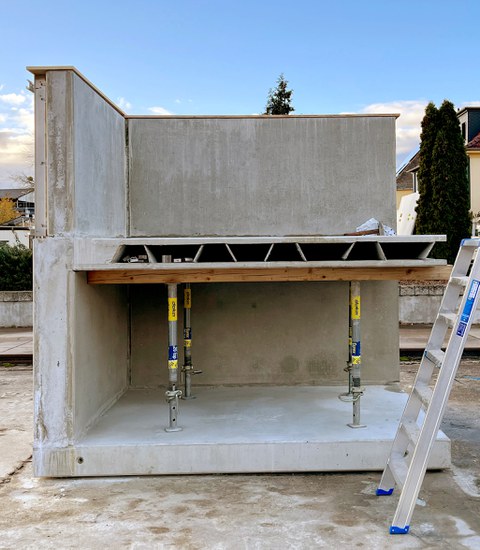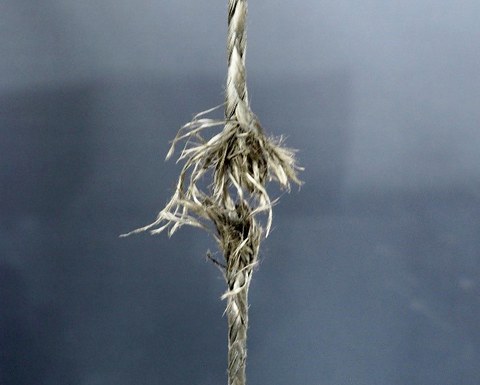Industry standard for CRC
Table of contents
Project data
|
Titel | Title |
Report in the annual report 2023
Guide for design and construction with CRC

Erection of the real-scale demonstrator within the project RUBIN-ISC
The main objective of the project is to develop an industry standard for the application of carbon-reinforced concrete. An important part of this will be to summarize the project results in a practical guide to the design and construction of carbon-reinforced concrete structures.
The Institute of Concrete Structures of TU Dresden focuses on the development of tools for the design of carbon-reinforced concrete components, provides guidelines for material selection and calculation of load-bearing capacity, and closes knowledge gaps in the area of serviceability. For that, a large number of laboratory tests are carried out to validate the design aids, define quality standards, and determine characteristic values for various material combinations, taking into account temperature and long-term effects. In addition, extensive investigations are carried out to determine the load-bearing capacity of formed carbon fiber reinforcements as a function of the degree of deformation and to determine the influence on the effective anchorage length.
During the course of the project, built-in parts for components such as fasteners and anchors for connection and transportation were also developed as an important step towards practical application. In this regard, for example, very thin concrete slabs with only a centrally embedded anchoring element are examined under various load conditions, considering both the behavior in unreinforced and in textile-reinforced slabs. The incorporation of textile reinforcement demonstrated significant advantages for the ultimate strength and crack behavior of the slabs. In a similar field of application also transport anchors have been developed and optimized for high-load carrying capacities.
A major achievement of the project is the completion of a full-scale demonstrator representing a part of a wall-ceiling structure. This includes a resource-efficient carbon-reinforced hollow-core slab system. In the core of such a slab, concrete is not required for load transfer and was therefore eliminated, significantly reducing the dead weight. The two chords are connected by reinforced concrete webs.
Report in the annual report 2022
Industry standard for carbon reinforced concrete

Destroyed braided rod from Johne & Groß GmbH after successful tensile test
The aim of the RUBIN-ISC project is to create an industry standard for the application of carbon reinforced concrete. This is to respond to the urgent need for a standardized approach to carbon-reinforced concrete construction. In doing so, RUBIN builds a bridge between research and construction practice. Gaps in knowledge are being closed and the knowledge gained is being prepared in a user-friendly way.
The main focus of our institute is the development of tools for the practical and generally valid design of carbon-reinforced concrete components. This includes developing guidelines for application-optimized material selection and ultimate limit state calculations for new composite materials, taking into account long-term and temperature effects. In addition, laboratory tests are being carried out, particularly for the technical testing of design aids for structural components, to ensure quality standards and to determine characteristic values for various material combinations, components and prototypes. At the same time, extensive research into formable reinforcement elements is being carried out in collaboration with our partner Johne & Groß GmbH.
In 2022, a resource-saving hollow-core slab system with a trapezoidal web consisting of two inclined webs and an upper and lower flange was initially developed and numerically analyzed. Special attention will be paid to the design of the bearing areas in order to adapt them to the different requirements. The integration of a shear reinforcement is to be carried out by means of 3D reinforcement grids made of carbon fibers. The slab elements mentioned above benefit from the shear reinforcement especially in the area close to the support, where the highest shear stresses are known to occur. After the calculation and structural design, the floor system is to be manufactured in the precast plant and then tested in the laboratory. The experimental results will be compared with the numerical results of the finite element program and, if necessary, form the basis for an adjustment of the model.
